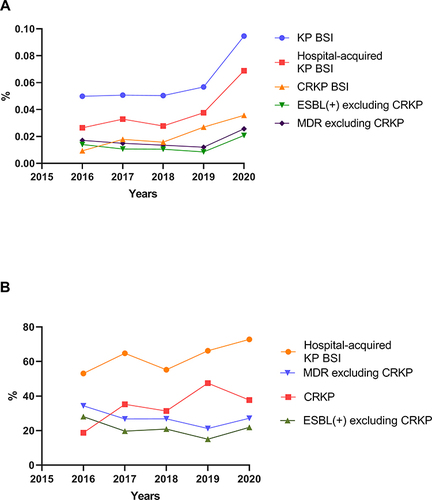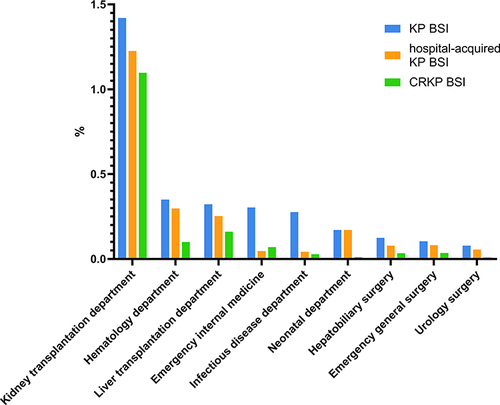Figures & data
Figure 1 (A) Proportion of different categories of KP BSI in total hospitalized patients from 2016 to 2020. (B) Proportion of different categories of KP in total KPBSIs from 2016 to 2020. The detection rate of KP BSI and CRKP BSI and the proportion of hospital-acquired KP BSI among total KP BSI increased over time. Except for patients with CRKP BSI, there was smaller increase in the proportion of ESBL positive KP BSI and MDR KP BSI in the total number of hospitalized patients, while the proportion of ESBL positive KP BSI and MDR KP BSI among KP BSI had a downward trend.

Figure 2 Department distribution of KP BSI (A), hospital-acquired KP BSI (B) and CRKP BSI (C) from 2016 to 2020. The primary setting of KP BSI, hospital-acquired KP BSI and CRKP BSI was the ICU.

Figure 3 Hospital-acquired infection rates of KP BSI, hospital-acquired KP BSI, and CRKP BSI by various departments. The number of ICU inpatients was difficult to determine, so they were not included in this figure.

Table 1 Antimicrobial Resistances of Klebsiella pneumoniae Isolated from Blood Samples from 2016 to 2020
Table 2 Antimicrobial Non-susceptibility of Carbapenem-Resistant Klebsiella pneumoniae Isolated from Blood Samples from 2016 to 2020
Table 3 Antibiotic Exposure and Use Histories of Patients with Hospital-Acquired and Non-Hospital-Acquired KP BSI
Table 4 Clinical Characteristics of the CRKP and CSKP Groups of Hospital-Acquired KP BSI
Table 5 Multivariate Logistic Regression Analysis of Risk Factors for CRKP BSI in Patients with a Hospital-Acquired Infection
Table 6 Univariate Analysis of Risk Factors Associated with 28-Day Mortality in Patients with Hospital-Acquired KP BSI
Table 7 Multivariate Analysis of 28-Day Mortality in Patients with Hospital-Acquired KP BSI
